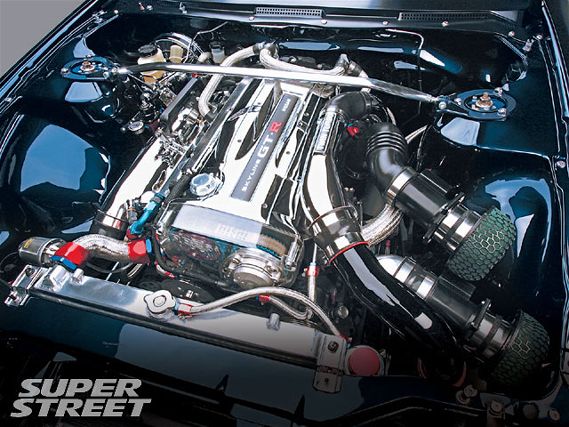 | October 2008 - Tech Support
| October 2008 - Tech Support
Where We Cure All Your Tech Problems
Stumped with a tech inquiry? We're here to help. Email us at: [email protected] or by writing in: Super Street, c/o Tech Support, 6420 Wilshire Blvd., Los Angeles, CA 90048.
Question Of The Month
Q I have a '98 Honda DX hatchback. I am currently running a 1.6 SOHC VTEC, but I have a B18C5 block with a '99 Si B16A head and transmission ready. I have the swap planned already but I want to do it right. The CV boots on the B18C5 are shot, and I was looking at aftermarket axle shafts, but I didn't find my application. I've heard the '94-'00 Integra axles will work but I wanted to ask the pros before the purchase. And will a Type-R LSD work with my setup? And what application would I buy cam gears for? I really appreciate your help.
Mike McCandlis
Via the Internet
A If you're not going with forced induction, you really don't need high-performance axles. Some stock replacement ones will do just fine for a naturally-aspirated or mildly-built car. Any axles from a '94-'01 Integra RS/LS/GS/GS-R will work. Make sure not to get the ones from a '97-'01 Integra Type-R; those have a larger diameter splined area and require different hubs. Differentials can get a bit complicated and it really depends on which transmission you have. If you have a transmission from a GS-R, then the Type-R LSD will fit in, but if you have transmission from any other Integra or even a Civic, then you would need to change out the ring gear and possibly the countershaft. If that's the case, you might be better off with an aftermarket LSD that fits in without having to change out more parts. As for the cam gears, they are all the same for any B series Honda engine. Buy any B series cam gears you fancy.
 | October 2008 - Tech Support
| October 2008 - Tech Support
QI have a '95 240SX with the stock KA24 motor. I have just gotten my hands on a full RB26DETT motor with ECU, wiring harness, turbos, etc. I know I will need an RB25 transmission to make it work in my 240SX, and one is already on its way. However, I still don't know a few things. Will I need a different subframe or crossmember to make it fit? Will I need a new driveshaft? Will my stock master and slave cylinders work with the new trans? And last but most certainly not least, will I need a standalone ECU to run it or can I just splice in the wiring for the accessories into the Skyline ECU? I would really appreciate the help.
Jose Matos
Via the Internet
A The crossmember will depend on which mount kit you use. Some mount kits will use the KA24 crossmember, and some will use the RB25 crossmember. If you weren't planning on using a mount kit, but instead planned on using the RB25DET Skyline GTS-T engine crossmember and brackets, then you will have a hood clearance problem, a shifter location problem, and a engine to radiator clearance problem. A custom driveshaft will have to be used. Keep in mind that the RB25DE and RB25DET transmissions are different, if ordering a custom driveshaft by mail. Lastly, you do not have to run a standalone ECU. Rewiring the Skyline ECU and harness to work in the 240SX is pretty common.
Q I recently bought an '02 RSX Type-S with a spun rod bearing. I'm already going to replace the rods with Eagle H-Beam rods. Now, I want to get the Jackson Racing Supercharger kit with the 3.2" pulley. Are the Eagle rods enough of an upgrade to safely run this setup, or do I need to get lower compression pistons too? Also doing dual valve springs, titanium retainers, valve seals, race header, exhaust, K-Pro. Thanks for your time.
Joseph Inman
Via the Internet
A The Eagle rods are a great addition to the supercharger. Lower compression forged pistons are another good move, as they don't expand and melt as quickly as the cast OEM pistons do. A header, exhaust and Hondata K-Pro would almost be mandatory to fully reap the benefits of a supercharger. Now the valve springs and retainers-those are not as necessary as they coincide with aftermarket cams.
Q I bought an aftermarket cold-air intake for my '06 Toyota 4Runner. It's sounds amazing but everytime I put it on, within the first couple days my check engine light comes on. I think it has to do with my air sensor. Do you have any ideas on how to make it run correctly?
Ricky Singleton
Mishawaka, IN
A Toyotas have a very sensitive mass air flow (MAF) sensor. With the installation of the new intake, some dirt could have gotten on the sensor. Simply remove the two screws and pull out the MAF. Then use some electronics parts cleaner to clean it. Re-install and the light should go away.
Q I have an '01 GSR. The head gasket was leaking so I decided to change it out myself. I was not too worried about it as I have a buddy who works at Honda, so I could get all specs that I needed. However, when I was removing the head bolts I noticed half of them twisted right out with no struggle. Apparently the threads inside the block became stripped and came out with the bolts. What I am wondering is what next step you would take. I do not really want to do any drilling myself because of the possibility of minute errors, but is it worth it to get all holes drilled and have time-serts installed at a machine shop, or should I take that money and buy a B20B and assemble the block and head myself?
Joe Matthews
Via the Internet
A Stripped head bolt threads are a very common problem on the B series engines. If done correctly, the time-serts will work fine. But we have seen them done incorrectly, and they just slip out again when torqued. The B20B option would save you money, since you can probably sell the GSR block for much more. But B20Bs have a really low compression ratio, which would only be good if you're planning on forced induction, such as a turbo or supercharger. Because the B20B was designed for non performance cars, it has more torque but also has a inferior rod to stroke ratio, keeping the redline low. The B18C has a better ratio along with a crank girdle allowing it to rev much higher. We say stick with the B18C. Just get the time-serts done right.
Q Right now I have a '93 Honda Civic DX sedan. I'm swapping out the stock D15 for a JDM B16A from a Civic SiRII. I had been ordering parts through a Honda specialist that had done swaps like this, but in the last few months, he has closed his shop, leaving me having to call dealers and order parts myself. My question to you is this: is the JDM B16A engine equivalent to the USDM B16A2 engine? I have seen multiple sites that suggest this but I needed to know from an expert and not just a random forum. Thanks for the help.
Shane Mikesky
Via the Internet
A Well, a Civic SiRII can mean either it came from a '88-'91 EF or a '92-'95 EG chassis. The main difference is the cable transmission (EF) versus the hydraulic one (EG). Assuming you have a B16A from a EG SiRII, this should be a straight bolt in for your '93 Civic. If you need replacement parts or missing parts, you can order things from a '94-'96 Del Sol VTEC B16A3. You'll need all four motor mounts, axles, shift linkage, computer and distributor. The B16A2 is from a '99-'00 Civic Si, and you will not be able to use the mounts nor computer from that car.
